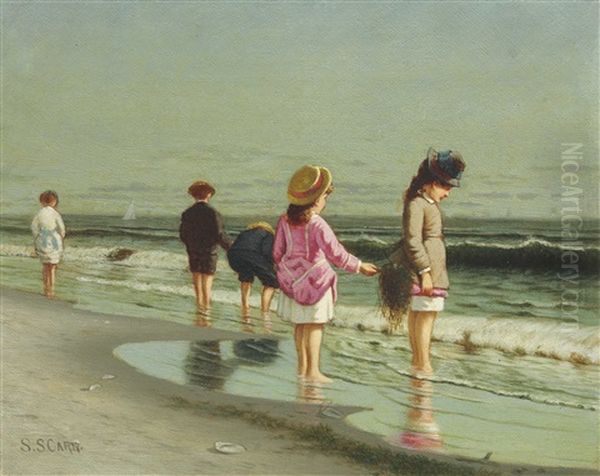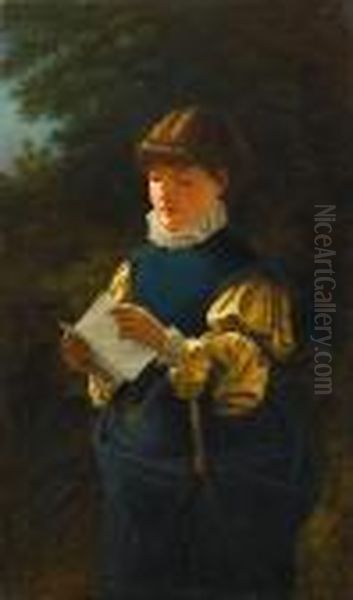Samuel S. Carr stands as a notable figure in late nineteenth-century American art, an artist born across the Atlantic who came to document the specific charms and burgeoning leisure culture of his adopted homeland. Active primarily in the latter half of the 1800s and the early 1900s, Carr carved a niche for himself with his gentle, detailed depictions of children, pastoral life, and, most distinctively, scenes of recreation along the American coastline. His work offers a window into the everyday moments and idyllic pursuits of the era, rendered with a careful hand and a clear affection for his subjects.
An Artist's Journey: From England to Brooklyn
Samuel S. Carr's story begins in England, where he was born in 1837. His early life and artistic inclinations in his native country laid the foundation for his later career. He received formal art training at the prestigious Royal School of Design in England. While the specific curriculum he undertook there is not detailed in available records, such institutions typically provided rigorous instruction in drawing, composition, and other foundational artistic principles, preparing students for careers in fine art or design.
A significant turning point in Carr's life came around 1862 when he emigrated to the United States. This move placed him in a dynamic and evolving American art scene. He chose to settle in the bustling city of New York, specifically making his home in Brooklyn. Sources indicate he resided in Brooklyn from at least 1879 until his death in 1908, suggesting a long and stable connection to the borough, which was itself a growing cultural center distinct from Manhattan. This environment would provide both the backdrop and the inspiration for much of his subsequent work.
The Artistic Milieu of Late 19th Century America
Upon arriving in America, Samuel S. Carr entered an art world marked by diverse trends. The Hudson River School's tradition of majestic landscape painting, exemplified by artists like Albert Bierstadt and Frederic Edwin Church, was still influential, celebrating the grandeur of the American wilderness. However, concurrently, there was a growing interest in genre painting – scenes depicting everyday life, which resonated with a public keen on seeing relatable narratives and familiar settings.

Artists such as Eastman Johnson were gaining renown for their portrayals of rural American life and domestic interiors. Winslow Homer, though also a powerful painter of nature's force, especially the sea, frequently depicted scenes of contemporary leisure, including coastal activities. The post-Civil War era saw increased urbanization and the emergence of a middle class with more time for recreation, making subjects like Carr's particularly relevant. Carr's focus on intimate, often cheerful scenes of children and seaside leisure positioned him within this genre tradition, distinct from the epic scale of the later Hudson River School painters like George Inness or Jasper Francis Cropsey.
New York City, and by extension Brooklyn, was solidifying its status as the nation's primary art hub. Institutions like the National Academy of Design provided crucial exhibition venues, while numerous galleries and artists' studios fostered a vibrant community. Carr's decision to settle in Brooklyn placed him within easy reach of this stimulating environment, allowing him to participate in its exhibitions and connect with fellow artists and patrons, even as he developed his unique focus on the specific charms of coastal Brooklyn and nearby shores.
Capturing Coastal Life: Style and Themes
Samuel S. Carr became particularly known for his focus on specific themes, primarily revolving around the lives of children, the tranquility of pastoral settings, and the allure of the seaside. His paintings often feature youngsters engaged in play, exploring the shore, or simply enjoying moments of quiet contemplation within a natural environment. These depictions are typically characterized by a gentle sentimentality and an optimistic outlook, reflecting perhaps the Victorian era's idealization of childhood innocence.
His style can be described as detailed and realistic, yet often imbued with an idyllic quality. He paid close attention to the rendering of figures, their clothing (often reflecting the fashions of the late 19th century), and the specific textures of the landscape, whether it be the sandy dunes of a beach or the grassy fields of the countryside. Unlike the broader, more atmospheric approach of the Impressionists who were emerging during his career, such as Childe Hassam, Carr maintained a clearer, more descriptive technique.

The seaside held a particular fascination for Carr. His beach scenes are among his most characteristic works. They often depict families and children enjoying the relatively new phenomenon of seaside recreation – strolling along the water's edge, digging in the sand, or simply taking in the sea air. These paintings capture the light and atmosphere of the coast, typically presenting calm waters and sunny skies, contributing to the overall feeling of peace and pleasant leisure that permeates his work. His approach contrasts with the often dramatic and turbulent seascapes rendered by contemporaries like Winslow Homer, focusing instead on the beach as a site of social interaction and gentle enjoyment.
The appeal of Carr's work likely lay in its accessibility and charm. In an era of rapid industrialization and social change, his paintings offered comforting visions of simple pleasures and natural beauty. His focus on children, rendered with sympathy and detail, resonated with popular tastes, similar perhaps to the way works by artists like John George Brown, known for his depictions of street urchins, or Seymour Joseph Guy, known for intimate childhood scenes, found favor, though Carr's settings were often more pastoral or coastal.
Focus on the Seaside
Carr's dedication to seaside subjects warrants special attention. Living in Brooklyn provided him with ready access to coastal areas like Coney Island and other stretches of the Long Island shore, which were rapidly developing as popular resorts and recreational destinations during this period. His paintings serve as valuable visual documents of this aspect of late 19th-century American life, capturing the attire, activities, and social dynamics of beachgoers.
His compositions often feature a low horizon line, emphasizing the expanse of sand, sea, and sky. Figures are typically arranged in small groups across the foreground and middle ground, engaged in various activities that draw the viewer into the scene. The light is usually bright and clear, suggesting pleasant weather and contributing to the overall cheerful mood. While not explicitly Impressionistic, Carr showed sensitivity to the effects of light on sand and water.
These works stand as a distinct contribution to American coastal painting. While artists like William Merritt Chase would later establish an art school at Shinnecock on Long Island and capture its landscapes with Impressionist flair, Carr's earlier depictions offer a more detailed, narrative-focused view of coastal leisure. His paintings celebrate the simple joy of a day at the beach, a theme that held broad appeal and continues to evoke a sense of nostalgia.
Notable Works
Several specific paintings exemplify Samuel S. Carr's style and thematic concerns:

Beach Scene (circa 1879): Considered one of his signature works, this painting is housed in the collection of the Smith College Museum of Art in Northampton, Massachusetts. It reportedly depicts a bustling yet relaxed beach environment, populated by figures in period dress enjoying the sun and sea. This work encapsulates his focus on seaside leisure and his ability to orchestrate multi-figure compositions within a landscape setting.
Kids on a Beach: The title itself points directly to Carr's recurring interest in children and coastal settings. While details like its current location might be transient if associated with auction houses like Christie's, its existence underscores the centrality of this theme in his oeuvre. Such works typically showcase children interacting naturally with the beach environment, digging, paddling, or collecting shells.
The Letter: This painting, held by the New Britain Museum of American Art in Connecticut, suggests a slightly different focus, likely a genre scene centered on a narrative element. While the specific subject isn't described in the source material, the title implies a moment of communication, anticipation, or perhaps quiet reflection, showcasing Carr's ability to handle more intimate, interior, or character-focused subjects alongside his landscapes and beach scenes.
These examples highlight the core elements of Carr's art: careful observation, a focus on relatable human activities (especially those of children), and a preference for pleasant, sunlit environments, particularly the seashore.
Exhibitions and Recognition
During his lifetime, Samuel S. Carr achieved a degree of professional recognition through his participation in significant art exhibitions. He was known to be a member of the Brooklyn Art Club, indicating his active involvement in the local artistic community of his adopted home borough. Membership in such clubs provided artists with opportunities for networking, mutual support, and exhibiting their work locally.
Furthermore, Carr exhibited his paintings at several prestigious institutions beyond Brooklyn. These included the Brooklyn Art Association, a key venue for artists in the borough. He also showed work at the Pennsylvania Academy of the Fine Arts (PAFA) in Philadelphia. As the oldest art institution in the United States, exhibiting at PAFA was a notable achievement, placing his work alongside that of many leading American artists, including figures associated with Philadelphia realism like Thomas Eakins or expatriates like Mary Cassatt who maintained ties.
Carr also exhibited at the National Academy of Design (NAD) in New York City. Founded in 1825, the NAD was (and remains) one of the country's most important art institutions, run by artists and architects. Acceptance into its annual exhibitions was a significant mark of professional standing within the American art world. Exhibiting alongside established academicians and promising newcomers at these venues helped solidify Carr's reputation during his career.
Collections and Legacy
Today, Samuel S. Carr's work is represented in the permanent collections of several American art museums. These include the New Britain Museum of American Art in Connecticut, which holds his painting The Letter, the Smith College Museum of Art in Massachusetts, home to his well-known Beach Scene, and the Clark Art Institute in Williamstown, Massachusetts (Note: referred to as Flint & Stanley Art Institute in one source, likely meaning the Clark). The presence of his work in these public collections ensures its preservation and accessibility for future study and appreciation.
Samuel S. Carr's legacy rests on his contribution to American genre painting, particularly his charming and detailed depictions of seaside life and childhood in the late 19th century. While perhaps not as revolutionary or widely acclaimed as some of his contemporaries who explored Impressionism or dramatic realism, Carr excelled at capturing a specific, gentle aspect of American life during his time. His paintings offer valuable historical insights into the leisure activities and social customs of the era, particularly the growing importance of the seaside as a place for recreation and relaxation.
His work provides a counterpoint to the grander landscape traditions and the more socially critical or psychologically intense art being produced by others. Carr found his voice in celebrating the simple, pleasant moments of everyday existence, rendered with a skillful hand and an evident warmth. He remains a significant figure for those interested in the art of Brooklyn, the depiction of childhood, and the visual chronicling of American coastal culture in the decades following the Civil War. His paintings continue to delight viewers with their accessible subjects and tranquil beauty.